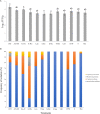Impact of Chemical and Alternative Fungicides Applied to Grapevine cv Nebbiolo on Microbial Ecology and Chemical-Physical Grape Characteristics at Harvest
- PMID: 32547588
- PMCID: PMC7272676
- DOI: 10.3389/fpls.2020.00700
Impact of Chemical and Alternative Fungicides Applied to Grapevine cv Nebbiolo on Microbial Ecology and Chemical-Physical Grape Characteristics at Harvest
Abstract
Viticulture is a cropping system in which treatment against fungal diseases (in particular powdery and downy mildews) can be extremely frequent. Accordingly, a reduction in antimicrobial treatments and the application of environmentally-friendly compounds are becoming increasingly important for a more sustainable viticulture. In addition to their effect against pathogens, the impact of these products on the quality of the grapes is very important for the oenological industries, but unfortunately at present few data are available. We evaluated the effect of the application of biocontrol products and resistance inducers in the vineyard on the mechanical properties, microbial ecology, technological and phenolic maturity of Vitis vinifera "Nebbiolo" grapes at harvest. The yield and vigor of vines were not influenced by the treatments, nor were the production of primary and secondary metabolites. However, the active ingredients influenced the mechanical properties of the skin (hardness and thickness). A significant hardening of the skin was detected when laminarin and chito-oligosaccharides were used, and sulfur induced a thickening of the skin with potential consequences for wine quality. Furthermore, the yeast community present on grape berries was influenced by the treatments. The abundance of Aureobasidium pullulans, the dominant species on the grape berry, changed in response to the compounds used. In addition, Alternaria sp. was reduced in some treatments with a potentially positive effect on the quality and the safety of the grapes. This study provides an overview of the effect of biocontrol products and resistance inducers on microbial ecology and "Nebbiolo" grape quality, contributing to the establishment of more sustainable and effective defense strategies in viticulture.
Keywords: antifungal compounds; grapevine berries; harvest; microbial ecology; powdery and downy mildews; texture analysis.
Copyright © 2020 Rantsiou, Giacosa, Pugliese, Englezos, Ferrocino, Río Segade, Monchiero, Gribaudo, Gambino, Gullino and Rolle.
Figures




Similar articles
-
The microbial ecology of wine grape berries.Int J Food Microbiol. 2012 Feb 15;153(3):243-59. doi: 10.1016/j.ijfoodmicro.2011.11.025. Epub 2011 Dec 2. Int J Food Microbiol. 2012. PMID: 22189021
-
Effects of fungicide application on physiological and molecular responses of grapevine (Vitis vinifera L.): a comparison between copper and sulfur fungicides applied alone and in combination with novel fungicides.Pest Manag Sci. 2023 Nov;79(11):4569-4588. doi: 10.1002/ps.7660. Epub 2023 Jul 28. Pest Manag Sci. 2023. PMID: 37434047
-
Long-Term Impact of Chemical and Alternative Fungicides Applied to Grapevine cv Nebbiolo on Berry Transcriptome.Int J Mol Sci. 2020 Aug 23;21(17):6067. doi: 10.3390/ijms21176067. Int J Mol Sci. 2020. PMID: 32842492 Free PMC article.
-
Status and future of disease protection and grape berry quality alteration by micro-organisms in viticulture.Lett Appl Microbiol. 2018 Aug;67(2):106-112. doi: 10.1111/lam.13033. Epub 2018 Jun 27. Lett Appl Microbiol. 2018. PMID: 29908033 Review.
-
A review of the use of biostimulants in the vineyard for improved grape and wine quality: effects on prevention of grapevine diseases.J Sci Food Agric. 2019 Feb;99(3):1001-1009. doi: 10.1002/jsfa.9353. Epub 2018 Oct 26. J Sci Food Agric. 2019. PMID: 30198154 Review.
Cited by
-
The Role of Biostimulants as Alleviators of Biotic and Abiotic Stresses in Grapevine: A Review.Plants (Basel). 2022 Jan 31;11(3):396. doi: 10.3390/plants11030396. Plants (Basel). 2022. PMID: 35161376 Free PMC article. Review.
-
Fungicides Cuprozin Progress and SWITCH Modulate Primary and Specialized Metabolites of Strawberry Fruits.J Agric Food Chem. 2023 Feb 8;71(5):2482-2492. doi: 10.1021/acs.jafc.2c06584. Epub 2023 Jan 24. J Agric Food Chem. 2023. PMID: 36693634 Free PMC article.
-
The Impact of a Commercial Biostimulant on the Grape Mycobiota of Vitis vinifera cv. Barbera.Microorganisms. 2023 Jul 25;11(8):1873. doi: 10.3390/microorganisms11081873. Microorganisms. 2023. PMID: 37630432 Free PMC article.
-
Grapevine Powdery Mildew: Fungicides for Its Management and Advances in Molecular Detection of Markers Associated with Resistance.Microorganisms. 2021 Jul 20;9(7):1541. doi: 10.3390/microorganisms9071541. Microorganisms. 2021. PMID: 34361976 Free PMC article. Review.
-
Carbohydrate elicitor-induced plant immunity: Advances and prospects.Heliyon. 2024 Jul 18;10(15):e34871. doi: 10.1016/j.heliyon.2024.e34871. eCollection 2024 Aug 15. Heliyon. 2024. PMID: 39157329 Free PMC article. Review.
References
-
- Alessandria V., Marengo F., Englezos V., Gerbi V., Rantsiou K., Cocolin L. (2015). Mycobiota of Barbera grapes from the Piedmont region from a single vintage year. Am. J. Enol. Vitic. 66 244–250.
LinkOut - more resources
Full Text Sources
Molecular Biology Databases

